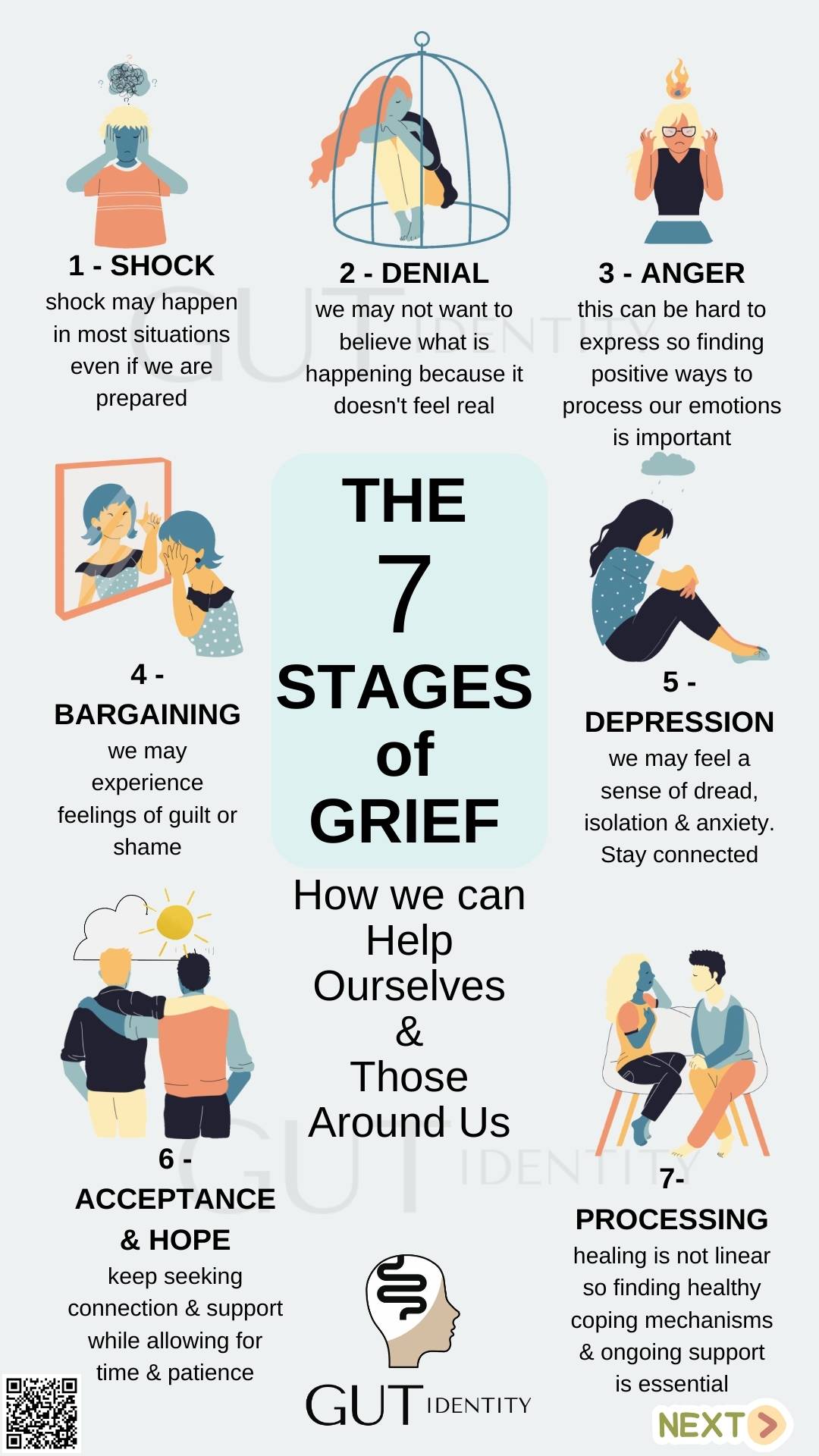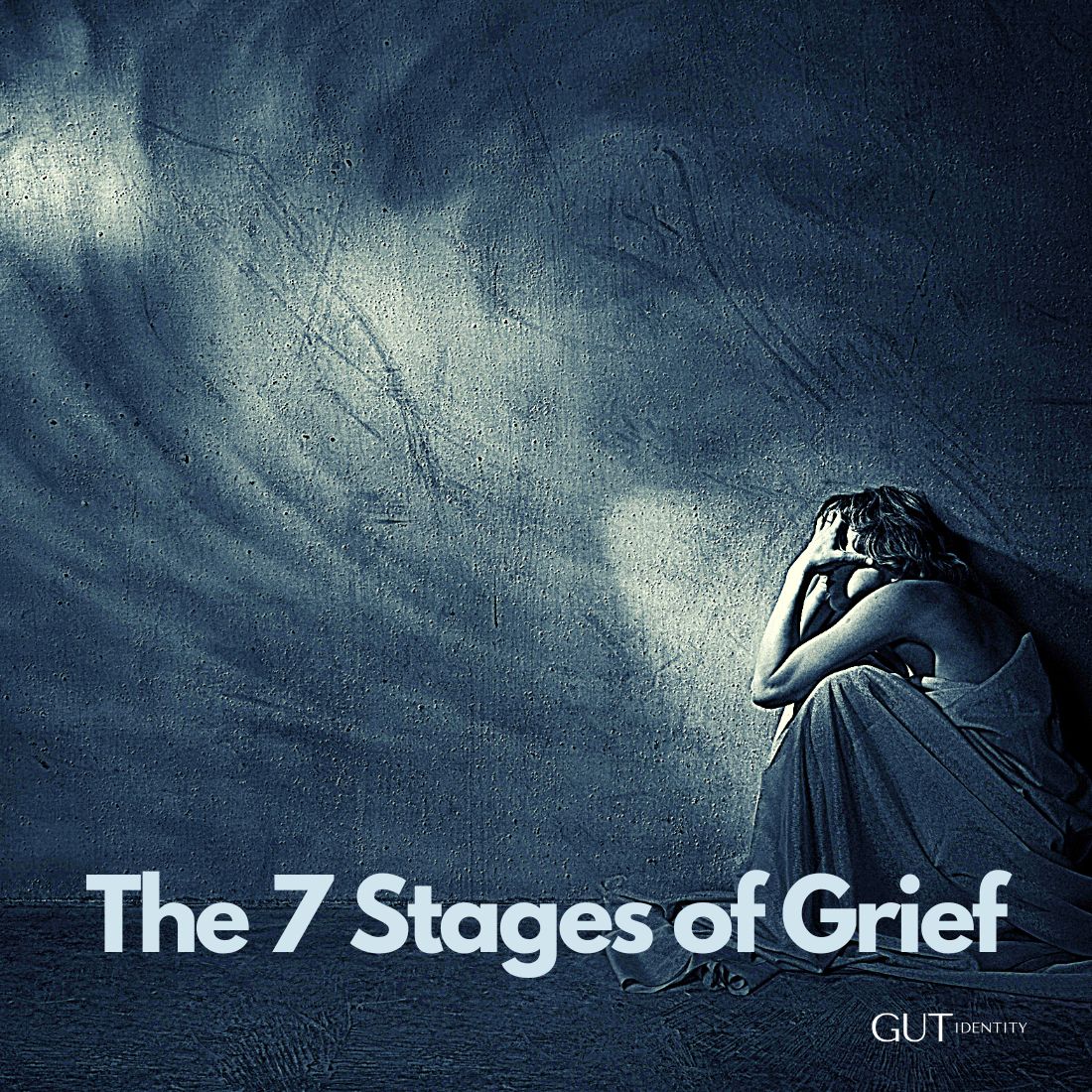We all face grief at some point in our lives and the 7 stages of grief explained by Kubler-Ross (which was updated from the 5 stages of grief), help explain the stages we move through in the grieving process. As I have faced my own grief over the past 4 years, I decided to create this graphic and break it down further with what’s helped me get through tough times. I created an Idea Pin on Pinterest about it but here it is with the hope it will help others along the way. Things do get easier so it’s important to give ourselves time to process the grief, be patient with ourselves, and give ourselves the time to heal.
The 7 stages of grief outlined

1. Shock
The shock stage of grief, often the initial response to a significant loss, involves a range of emotional and physical reactions. We may experience emotional numbness, characterized by feelings of disbelief and denial, as the reality of the loss hasn’t fully set in yet. Physical reactions such as a racing heart, dizziness, nausea, or a sense of feeling physically cold can also occur.
During this stage, we may feel disoriented and may have difficulty concentrating, making decisions, or processing information. Emotional outbursts, including sudden and intense episodes of crying or anger, may happen unexpectedly and this is ok. This stage serves as the body’s way of initially protecting itself from the full impact of the loss, allowing us to gradually absorb the reality of what has happened. For me, this stage can last a few days.
How I cope with this, is I put my trust in the Universe and let the process do its thing. If you are a person of faith, put your trust in that. Whatever you are into, it does help to surrender the problem over to something else and try to go with the flow.

2. Denial
The denial stage of grief is a defence mechanism that helps us cope with the initial shock of a loss. During this stage, we may struggle to accept the reality of the situation, often thinking or saying that it can’t be true or that there’s been a mistake. This disbelief can manifest in various ways, such as avoiding conversations about the loss, refusing to acknowledge its impact, or continuing life as if nothing has changed. Denial serves as a buffer, giving our minds time to adjust to the overwhelming emotions associated with the loss. It allows us time to process the reality of a situation more gradually, preparing us to face the next stages of grief with greater emotional resilience.
How I cope with this stage is to rely on healthy coping mechanisms. The worst thing I could do for myself during this stage is sit and binge Netflix or drink alcohol. I intensely look after my mental and physical health during this stage. If a thought comes into my mind (this could be an intrusive thought), I let it come and go without grabbing hold of it. That way, I’m not ignoring it or buying into it. Let thoughts come and go and keep looking after your health. I find I can move through this stage by saying to myself that I accept what has happened and focus on the positive things I have in my life currently.

3. Anger
The anger stage of the grief process can be explained by intense feelings of frustration and helplessness, often directed toward various things. We may feel anger at ourselves, others, or the situation itself, questioning the fairness and reason behind the loss or bad situation. This anger can be irrational and misplaced, leading to strained relationships and conflicts.
We might find ourselves asking “Why me?” or “How could this happen?” as we struggle to make sense of their pain. The anger stage serves as an emotional outlet, allowing us to release pent-up feelings that we may not yet fully understand. While it can be a turbulent period, experiencing anger is a natural part of grieving and can eventually lead to a deeper understanding and acceptance of the loss.
We can either be angry at ourselves, or someone else during this stage, but holding on to this anger will ultimately only harm our own health. Find ways to learn to let go of where the anger is directed. This could mean forgiving a person or situation that has caused the loss. It’s not easy but it does help us feel better in the short term. Everything takes time, and this includes getting over the anger. Channel frustration into positive things. I spend a lot of time in nature and ‘moving’ when angry about a situation. This not only helps me release feelings of angst within my body, but it also helps me come up with solutions to problems.

4. bargaining
The bargaining stage of the grief process involves trying to regain a sense of control and prevent the loss or its consequences. In this stage, we may find ourselves making deals or promises, either to a higher power or to ourselves, in an attempt to reverse or change the situation. We might think, “If only I had done something differently” or “I promise to change if this can be undone.”
Bargaining often reflects a deep sense of guilt or responsibility, as we replay scenarios in our minds, searching for ways we could have influenced or changed the outcome. This stage is marked by a mixture of hope and desperation, as we hold on to the possibility of altering the reality of our loss. Although it can be emotionally taxing, bargaining is a crucial part of the grieving process, helping us to confront our feelings of vulnerability.
Helping ourselves during the bargaining stage of grief involves acknowledging and addressing the complex emotions we experience. Accepting that it is natural to feel guilt, responsibility, and desperation is crucial, allowing these emotions without judgment. I like to seek support from friends, family, but we can also seek support from support groups to share our thoughts which can provide comfort and perspective.
Expressing myself through journaling, art, and other creative outlets has helped me process emotions in a healthy way.

Another really good strategy is to practise self-compassion and recognise that you did the best you could with the resources available at the time is important. This has been central to my personal development during really tough times. I didn’t know what I didn’t know and did the best I could at the time.
Focusing on small, manageable tasks can help us regain a sense of control and purpose. Engaging in mindfulness or meditation can keep you present and reduce anxiety about the past or future. These strategies can aid in processing feelings and moving toward healing during the bargaining stage of grief.

5. Depression
The depression stage of grief is marked by profound sadness and a sense of deep loss as the reality of the situation fully sets in. During this stage, we may feel overwhelmed by feelings of emptiness, hopelessness, and despair. We might want to withdraw from social activities and isolate ourselves, finding little pleasure in things that once brought us joy.
Physical symptoms such as fatigue, changes in appetite, and difficulty sleeping are also common. This stage is characterized by introspection and a heightened awareness of the permanence of the loss, leading to a period of mourning and reflection. While deeply painful, the depression stage is a crucial part of the grieving process, allowing us to confront and process their grief on a deeper level, paving the way for eventual acceptance and healing.
Helping ourselves during the depression stage of grief involves taking proactive steps to care for our mental and physical well-being.

Acknowledging and accepting our feelings of sadness and despair is crucial, allowing us to experience these emotions without self-judgment. Seeking support from trusted friends and family, and doing regular physical activity, even gentle exercises like walking can improve mood and energy levels. I try to stick to a routine, including regular sleep patterns and healthy food, as this helps greatly.
If the depression feels too intense or prolonged, seek professional help from a therapist or counsellor as this can provide valuable guidance and support especially when times are really tough. These strategies are ones I try myself and can help us navigate the depression stage of grief, fostering resilience and helping the healing process.

6. acceptance & hope
The acceptance and hope stage of the grief process signifies a turning point where we can begin to come to terms with our loss and see a future beyond our grief. In this stage, there is a recognition of the reality of the loss, and although the pain may still be present, it becomes more manageable.
In this stage, we can start to find ways to move forward. We might also experience a renewed sense of purpose or find new interests and activities that bring joy and fulfilment. Hope emerges as we start to see the possibility of a future that, while different, can still be positive. This stage does not imply forgetting the loss but rather finding a way to live with it and grow from the experience. Acceptance and hope mark the beginning of emotional healing, allowing us to rebuild our lives while honouring the memory of what we have lost.
Be ok with relying on the people around you. For me, this was my parents. Remember that everything is just temporary and that things always get better in the end – because they always do!

Related post
7. processing
The processing stage of grief is a pivotal point where we can actively work through our emotions, thoughts, and experiences related to a loss. During this stage, we can engage in introspection, reflection, and expression to make sense of our grief. We might revisit memories, confront unresolved feelings, and seek understanding about the impact of the loss. Processing involves acknowledging and accepting the full range of emotions—from sadness and anger to guilt and longing—while gradually integrating these feelings into our sense of self.
This stage often involves seeking support from others, whether through therapy, support groups, or trusted friends and family members, to navigate the complexities of grief. By processing our grief, we can begin to find meaning and purpose in the loss, fostering our personal growth and resilience as we move forward in our healing journey.
Just remember, things always get better. What might seem awful right now, might feel better tomorrow. Hang in there and keep going!

final thoughts

It’s important to remember that we all process grief differently and we might not pass through all stages in the same order. Even two people experiencing the same grief will be different because we have different beliefs, perspectives, and different histories. Being patient with ourselves, and giving ourselves the time and space needed to process emotions is critical. I’ve found that time really does help in the healing process, and when I feel certain emotions well up again, I don’t give myself a hard time. I remind myself that I still haven’t fully healed and that that’s ok.
If you are going through grief right now and feel like you need more support, reach out. Contact a helpline, or reach out to family or friends. Trying to do things on our own is hard. There’s always someone willing to help if we need it. A gentle reminder, this post should not take the place of specialised support. Please seek help immediately if you need to.





Very well stated. You added a number 7 to my 6 …
Thank you!